| Admissions | Accreditation | Booksellers | Catalog | Colleges | Contact Us | Continents/States/Districts | Contracts | Distance Education | Emergency | Examinations | Forms | Grants | Hostels | Honorary Doctorate degree | Investment | Instructors | Lecture | Librarians | Membership | Professional Examinations | Programs | Progress Report | Recommendations | Research Grants | Researchers | Students login | School | Search | Seminar | Study Center/Centre | Sponsorship | Tutoring | Thesis | Universities | Work counseling |
|
AIRWAY CONTROL & MAINTENANCE Introduction Warning A - Opening the airway : Jaw Thrust Method B - Opening the airway: Chin lift method C - Oropharyngeal airway D - Nasopharyngeal airway Endotracheal intubation Orotracheal intubation Nasotracheal Intubation Introduction Life Saving measures in any emergency situation is described under the acronym ABCD. “A” stands for airway. Unless the airway is patent breathing (B) will not be adequate or possible and this will undoubtedly lead to cardiac (C) circulatory problems. If the airway problem is taken care of, most of the emergency situations could be avoided. The problems that interfere with airway is obstruction to the passage anywhere from the nostrils down to the larynx and trachea by any one of the processes described below. It causes limitation of air entry into the lungs resulting in hypoxia leading to death.The airway is normally protected by the patient’s ability to swallow or cough out and clear nasopharyngeal, oropharyngeal and tracheal secretions. However, in an unconscious patient when these reflexes do not function well, these protective mechanisms will not be available.Obstruction to airway is caused by : 1. Tongue falling backwards obstructing the oropharynx in an unconscious patient 2. Secretions that collect in the oropharynx in an unconscious patient who is not able to clear it 3. The stomach contents being aspirated into larynx and trachea and filling up the oropharynx 4. Facial injuries resulting in nasopharyngeal trauma causing continuous oozing of blood and clots causing obstruction to the nasopharynx and oropharynx. 5. Foreign bodies inadvertently aspirated into larynx and trachea resulting in acute obstruction (dentures) 6. Anesthetic agents and toxic substances ingested or inhaled causing the loss of gag reflux. 7. Any unconscious status - coma due to disease or drugs - anesthesia, seizure disorders - Electro convulsive therapy etc. Irrespective of the cause of obstruction the effect is the same. The family physician and the first contact person should be able to do a few basic preliminary procedures that would prevent disastrous results due to airway obstruction. Warning In any patient who has sustained multiple trauma or had a fall from heights or has head injury, it is always better to suspect injury to the cervical spine and he/she has to be handled carefully in such a manner that the neck is not manipulated or extended and appropriate neck support provided. Airway management The first step, which most often helps the patient in managing airway, is to maintain him in a supine posture. In this position the whole body could be tilted to one side like a log to provide drainage from the mouth to gravitate out. When there is no suspicion of neck injury this could be accomplished just by turning the head to one side. The next step is to make sure that all foreign bodies and secretions are removed from the back of the throat. The jaw can be lifted with a thumb inside the oral cavity pressing on the tongue and the other fingers protecting the chin with the left hand. The right hand index and middle fingers (gloved) is swept inside the mouth and with a swooping movement foreign bodies and secretions in the oropharynx are brought out. This is followed by adequate suctioning of the oropharynx to clear of secretions, aspirates from the stomach, foreign bodies etc. If the tongue is flopping backwards applying a tongue forceps to the anterior tongue this can be drawn forward to provide direct airway without obstruction. (Arrows point to airway obstruction due to tongue falling backwards). A - Opening the airway : Jaw Thrust Method 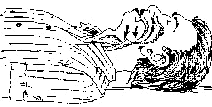 Grasp the angles of the Jaw with both hands and displace the mandible forwards. This clears obstruction by tongue and opens Airway Passage. B - Opening the airway: Chin lift method 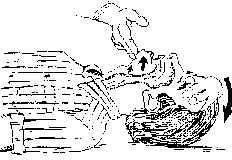 Fingers of one hand placed under the mandible and gently lift the chin forwards. The lower lip is depressed with the thumb to open the mouth. Note: Head tilt as shown above will help improve airway. But hyperextension or flexion of neck must be avoided if cervical spine injury is suspected or has not been ruled out. C - Oropharyngeal airway 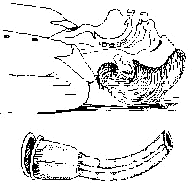
Requirement: 1. Tongue depressor (blade) 2. Selected appropriate size airway (incisor teeth to angle of the mandible) 3. Suction machine if available. Procedure: * Chin lift - open mouth * Depress tongue with blade * Insert airway backwards gently sliding over the curvature of tongue * Airway flange should be out of the mouth. * Remove tongue blade and secure airway. * Suction as necessary. * Face mask and ventilation as necessary D - Nasopharyngeal airway Ideal when patient is somewhat conscious - better tolerated than oropharyngeal. 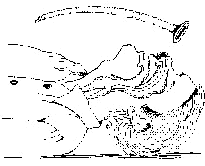
Requirements: 1. Appropriate size Nasopharyngeal airway (Nostril to pharynx size) 2. Lubricant ((K.Y. Jelly) Procedure: * Select the nostril that is not obstructed. Lubricate the airway selected and * Gently insert the tip through the nostril and slowly advance the same towards the ear with a gentle rotary movement till the flange comes in contact with the external nostril (Now it is in hypopharynx).. * Face mask ventilation as necessary Definitive Airway Control and Management Endotracheal intubation: Consider endotracheal intubation when definitive airway is needed under the following circumstances: a. If patient’s airway is obstructed inspite of the placement of oropharyngeal/nasopharyngeal airway and ventilation. b. Patient is not breathing (apnoea) c. Inadequate air exchange with or without other problems like pneumothorax, hemothorax, pericardial tamponade etc. all would require immediate intervention. d. To prevent aspiration of stomach contents into the trachea in unconscious patients e. Where inhalation burns, status epileptics, head trauma and facial fractures are suspected. Endotracheal intubation and ventilation is a safe and reliable method of oxygenation. Endotracheal intubation is a skill that can be learnt with ease and confidence and undoubtedly is a Life Saving Measure that every family practitioner should handle competently. Endotracheal intubation can be performed through the oral cavity (orotrachea) or through the Nasal cavity (Nasotrachea). Both these methods are simple skills that require all paramedics, nurses, primary care physicians and emergency personnel should learn.(We recommend that during contact sessions DFH students practice these skills with a manikin). Learning skills: - Basic anatomy of the nasooropharynx, glottis and trachea should be understood - The glottis opening should be easily recognized 
Please refer to the Anatomical diagram “A” and identify the vallecula, vocal cords, epiglottis and glottic opening. 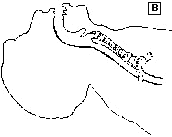
On the diagram “B” mark tongue, pharynx, vallecula, epiglottis, glottic opening and the trachea. 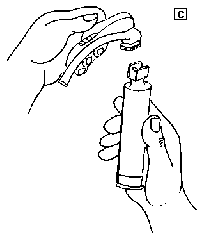
This simple exercise will familiarize with the basic anatomical knowledge that is required for endotracheal intubation. Also look at diagram “C” and familiar yourself with the parts of Laryngoscope. Laryngoscope has a handle which contains batteries and a blade with a bulb for light source. The blade can be either a straight one or a curved one. The handles and blades come in different sizes to suite different age groups. It is very important that every family practitioner has in possession the following items: 1. Adult laryngoscope with at least one curved blade, one straight blade, spare bulbs and batteries 2. One similar paediatric set 3. Endotracheal tubes of different sizes 4.Ambu bags. 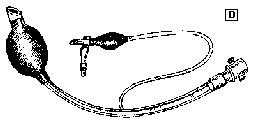
Figure “D” shows endotracheal tube and they come in different sizes. The modern endotracheal tube has a inflatable cuff at the end and through a separate portal the cuff can be inflated by injecting a few ccs or air. By utilizing the cuffed endotracheal tube the following are accomplished: a. It is possible to prevent aspiration of stomach contents totally by snugly inflating the cuff b. The air filled sac is less traumatizing to the mucosa of the trachea than the rough tube itself and less likely to scrip out. c. If a patient has to be ventilated air leak will not take place. We recommend that Family Practitioners use cuffed endotracheal tubes. These are disposable ones and are easily available. Orotracheal intubation: Requirements: a. Laryngoscope b. Endotracheal tubes (stylet included) c. Suction machine d. 10 cc Syringe e. Ambu bag / ventilator f. Stethoscope Position: Endotracheal intubation in emergencies is done with a patient in recumbent posture and where neck injury is suspected, an assistant to hold the neck in neutral position without hyperextension or flexion is recommended. Procedure: * Make sure that the suction is functional. * Make sure the laryngoscope is ready with functional bulb. * Make sure the cuffed endotracheal tube is intact and cuff is not leaking by injecting air and checking it. * As a first step if the patient is breathing with face mask, ventilation and oxygenation is to be continued. * The laryngoscope with a curved blade is introduced into the oral cavity. * The mouth and pharynx is opened enough to suction quickly and clear any secretions. * With the laryngoscope in the left hand, it is applied into right side of the patient’s mouth, the blade displacing the tongue towards the left. * At this point, it is possible to visualize the epiglottis and the vocal cords. * Gently insert the endotracheal tube into the trachea without injuring the oral cavity with the scope. * Once the tube is comfortably placed inside the trachea, inflate the cuff with a few ccs of air to provide a leak proof seal. * Using an ambu bag inflate the lungs through the endotracheal tube and check for breath sounds on both sides of the chest in all areas with a stethoscope. This is a very vital step as it is important to make sure that the tube has not passed beyond the carina to one bronchus (thereby cutting of the ventilation to the other lung). * Once a satisfactory placement is accomplished the orotracheal tube can be fixed with adhesive tapes and ventilation carried utilizing ambu bag or ventilator. * A chest x-ray if available could be obtained to make sure that the position of the tube within the trachea is acceptable. Note: Only way one to be sure that the tube is not in the esophagus and that it is well in trachea is by a careful examination performed on both sides of the chest to watch for movement of the chest as well as breath sounds heard on auscultation. Endotracheal intubation has to be accomplished promptly and quickly without wasting time and it is better to have everything ready before starting the procedure while making sure that the patient is being oxygenated and ventilated. In an apneic patient this has to be accomplished with precision and speed.It is better not to make more than one or two trials of introducing the tube and if it is not successful, try a few seconds later after adequately oxygenating and ventilating with a face mask and ambu bag. Repeated traumatizing efforts without giving breaks with ventilatory support should not be attempted. After the placement of endotracheal tube if there is evidence of thick secretions or gastric aspirate this has to be suctioned out. Frequent, continuous suction without oxygenation and ventilation in between should be avoided. Intermittent suction after adequate ventilation is the procedure of choice when necessary. Where facilities exist O2 saturation level could be documented using pulse oximeter. Note: At times it becomes difficult to expose the glottis utilizing a curved laryngoscopic blade. In such cases it may be worthwhile making the next attempt with a straight blade. 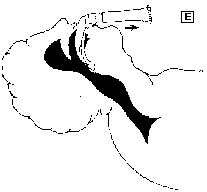
Advantage: When curved blade is used, the epiglottis is pulled upwards with the tip of the blade in the vallecula (E), 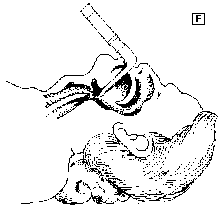
where as with the straight blade it is placed on the epiglottis which is elevated to expose the glottis (F). The use of a stylet inside the endotracheal tube may come in handy to make the passage of the tube through the glottis easier and also to contour the tube curvature as needed. If a stylet is used it must be withdrawn as soon as optimal entry of the tube in the trachea is obtained. Nasotracheal Intubation Under most circumstances orotracheal intubation is adequate and is quicker to accomplish. In select circumstances, and in particular, in a semi-alert patient with head injury it may be beneficial to use nasotracheal intubation. Once placed properly it is tolerated and retained by the patients much better and is unlikely to be coughed up, chewed or spit. Requirements: The requirements for nasotracheal intubation is essentially the same. Xylocaine Jelly is recommended for the lubrication of the nostril as well as the tube. Contra indications: 1. Nasal and facial bone fracture 2. In apneic patients nasotracheal intubation would require to listen to breath sounds and in apneic patients that is not possible. 3. In patients with basal skull fracture and CSF rhinorrhea. Procedure: * Patient is placed in supine position * An Assistant is requested to hold the head and neck in neutral position. * Check all the gadgets (ET tube, Suction etc) * Ventilate well with face mask and Ambu bag. * Spray the nasal passage with local anesthetic or apply xylocaine jelly to the nostrils. * Pass an appropriate size well lubricated endotracheal tube through the nostril and gently advance this towards the pharynx. * First pass it through the nostril and then backwards towards Pharynx. * It may be helpful to align the curve of the tube to facilitate the passage and use of stylet is recommended to maintain this curvature. * Once the tube is in the pharynx listen to the airflow through the tube and gradually position the end of the tube close to the glottis where the air flow is maximal. * At a point when the patient is inhaling pass tube quickly into the trachea and advance into it to an optimal position. This could be further helped if a gentle pressure is made on the thyroid cartilage prior to introduction of the tube. * Once the tube is in place use the Ambu to inflate the chest and make sure there is good bilateral chest movements and also with the stethoscope auscultate both sides of the chest. However, it is always better to confirm the position of the endotracheal tube with a chest x-ray taken as soon as possible. Although some what difficult to perform nasotracheal intubation skill comes in handy in select patients and have distinct advantages. |
